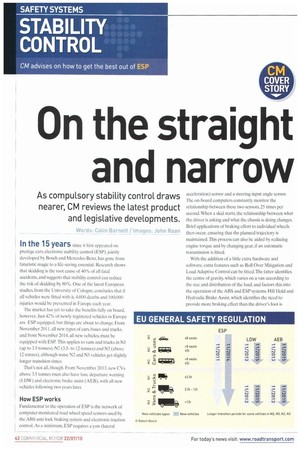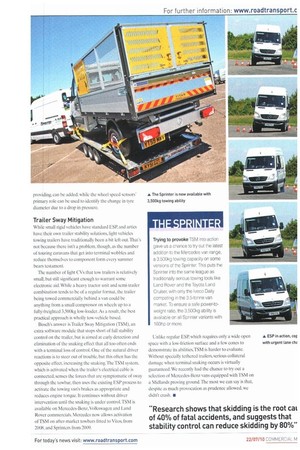On the straight and narrow
Page 42

Page 43

If you've noticed an error in this article please click here to report it so we can fix it.
As compulsory stability control draws nearer, CM reviews the latest product and legislative developments.
Words: Colin Barnett / frtiayeS: John Roan In the 15 years since it first appeared on prestige cars, electronic stability control (ESP). jointly developed by Bosch and Mercedes-Benz, has gone from futuristic magic to a life-saving essential. Research shows that skidding is the root cause of 40% of all fatal accidents, and suggests that stability control can reduce the risk of skidding by 80%. One of the latest European studies, from the University of Cologne, concludes that if all vehicles were fated with it. 4.000 deaths and 100.000 injuries would be prevented in Europe each year.
"the market has yet to take the benefits fully on hoard, however. Just 42% of newly registered vehicles in Europe are ESP equipped. but things are about to change. From November 2011, all new types of cars, buses and trucks. and from November 2014. all new vehicles, must be equipped with ESP. This applies to vans and trucks in Ni (up to 3.5 tonnes), N2 (3.5to 12-tonnes) and N3 (above 12 tonnes), although some N2 and N3 vehicles get slightly longer transition times.
That's not all, though. From November 2013, new CVs above 3.5 tonnes must also have lane departure warning (LDW) and electronic brake assist (AEB), with all new vehicles following two years later.
How ESP works
Fundamental to the operation of ESP is the network of computer-monitored road wheel speed sensors used by the ABS anti-lock braking system and electronic traction control. As a minimum, ESP requires a yaw (lateral acceleration) sensor and a steering input angle sensor. "Me on-hoard computers constantly monitor the relationship between these two sensors, 25 times per second. When a skid starts, the relationship between what the driver is asking and what the chassis is doing changes. Brief applications of braking effort to individual wheels then occur, ensuring that the planned trajectory is maintained. This process can also be aided by reducing engine torque and by changing gear, if an automatic transmission is fitted.
With the addition of a little extra hardware and software, extra features such as Roll Over Mitigation and Load Adaptive Control can he fitted:The latter identifies the centre of gravity, which varies on a van according to the size and distribution of the load, and factors this into the operation of the ABS and ESP systems. Hill Hold and Hydraulic Brake Assist, which identifies the need to provide more braking effect than the driver's foot is
providing, can be added, while the wheel speed sensors' primary role can be used to identify the change in tyre diameter due to a drop in pressure.
Trailer Sway Mitigation
While small rigid vehicles have standard ESP. and artics have their own trailer stability solutions, light vehicles towing trailers have traditionally been a hit left out.That's not because there isn't a problem. though, as the number of touring caravans that get into terminal wobbles and reduce themselves to component form every summer bears testament.
The number of light CVs that tow trailers is relatively small, but still significant enough to warrant some electronic aid. While a heavy tractor unit and semi-trailer combination tends to be of a regular format, the trailer being towed commercially behind a van could be anything from a small compressor on wheels up to a fully-freighted 3500kg low-loader. As a result, the best practical approach is wholly tow-vehicle based.
Bosch's answer is Trailer Sway Mitigation (TSM), an extra software module that stops short of full stability control on the trailer, but is aimed at early detection and elimination of the snaking effect that all too often ends with a terminal loss of control. One of the natural driver reactions is to steer out of trouble. but this often has the opposite effect, increasing the snaking.The TSM system. which is activated when the trailer's electrical cable is connected, senses the forces that are symptomatic of sway through the towbar, then uses the existing ESP process to activate the towing van's brakes as appropriate and reduces engine torque. It continues without driver intervention until the snaking is under control, TSM is available on Mercedes-Benz, Volkswagen and Land Rover commercials. Mercedes now allows activation of TSM on after-market towbars litted to Vitos, from 2008. and Sprinters from 2009.
Unlike regular ESP, which requires only a wide open A ESP in action, cop
space with a low-friction surface and a few cones to with urgent lane chz demonstrate its abilities, TSM is harder to evaluate. Without specially tethered trailers, serious collateral damage when terminal snaking occurs is virtually guaranteed. We recently had the chance to try out a selection of Mercedes-Benz vans equipped with TSM on a Midlands proving ground. The most we can say is that, despite as much provocation as prudence allowed. we didn't crash. •
























































































































